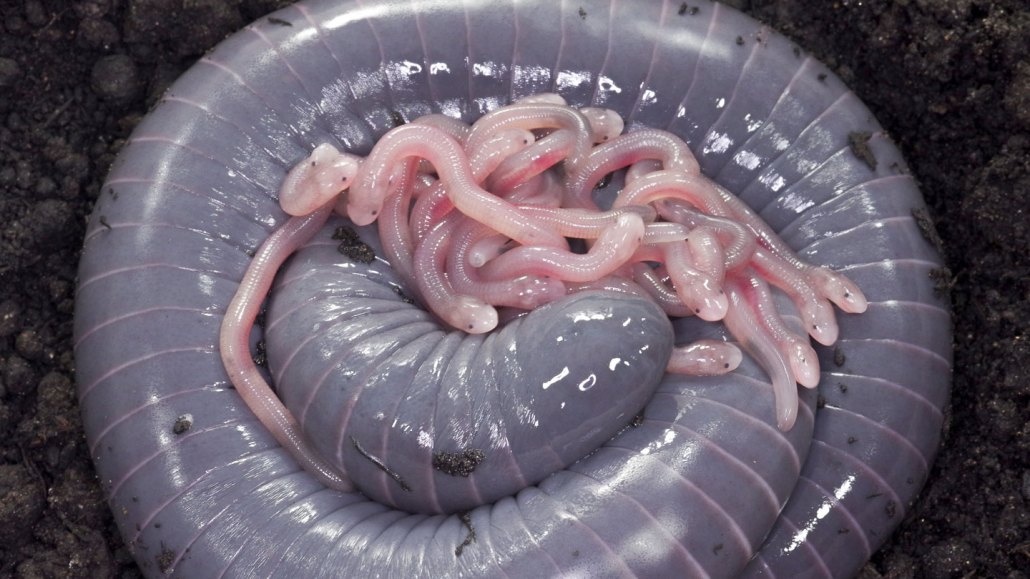This egg-laying amphibian feeds its babies ‘milk’
Like mammals, these legless, burrowing animals make a nutrient-rich fluid for their young

A female ringed caecilian is shown with her babies. This species feeds its babies a fat-rich fluid. Made in the reproductive tract, this fluid is similar to mammals' milk.
Carlos Jared
Share this:
- Share via email (Opens in new window) Email
- Click to share on Facebook (Opens in new window) Facebook
- Click to share on X (Opens in new window) X
- Click to share on Pinterest (Opens in new window) Pinterest
- Click to share on Reddit (Opens in new window) Reddit
- Share to Google Classroom (Opens in new window) Google Classroom
- Click to print (Opens in new window) Print
By Jake Buehler
In a humid coastal rainforest, a litter of pink, hairless babies snuggle with their mom. They stir and squeak for milk and drink from their mother until they are full. But these are no puppies or cubs. They are snake-shaped amphibians, far closer to frogs than to foxes.
Mammals are named for their ability to produce milk. But scientists have found that a few species that are not mammals feed their young this way, too. These include certain spiders, fishes, cockroaches and birds — and now, snake-shaped amphibians. Ringed caecilians (Siphonops annulatus) are the first amphibians known to feed hatchlings a kind of “milk.” Researchers reported their new finding March 8 in Science.
Caecilians (Seh-SEEL-yenz) have many strange features. Rarely seen, they are burrowing creatures that are nearly blind. Some species, like the ringed caecilian, have poisonous slime and may be venomous. They feed their own skin to their young.
Herpetologist Carlos Jared of the Instituto Butantan in São Paulo, Brazil, has been studying these animals for years. After hatching, ringed caecilian babies live with their mothers for two months. Jared and his research team found that the babies spent much of their time around the end of their mom’s body. That’s where there’s an opening called a vent. It’s shared by mom’s reproductive, digestive and urinary systems.
Jared’s team saw the female would expel a thick fluid from her vent. Her young then would enthusiastically feed on it.
“Some [young] even stuck their heads inside this opening,” Jared notes.
Caring for their young
For the new study, the team worked in Bahia state in Brazil. They collected 16 females and their babies, then observed them in the lab. In all, they videoed these mothers and babies for more than 240 hours.
Feedings started with the babies wriggling and nibbling at their mother’s vent. They also made high-pitched noises. Mom would then raise that end of her body and release the fluid. This happened up to six times per day. It looked like the mothers were responding to the babies’ pleas.
The squeaking and begging is a fascinating observation, says Mark Wilkinson. He’s an evolutionary biologist in England at the London Natural History Museum. Adult ringed caecilians are thought to be sensitive only to lower pitched sounds, he says. So it’s surprising that moms seem to respond to high-pitched noises from their young.
The researchers examined the internal anatomy of some of the adult females. They also analyzed the fluid. It’s secreted by glands in the tube through which eggs travel from an ovary. (This is known as an oviduct.) The glands enlarge while a female is raising her hatchlings.
This “milk” is rich in fats, much as mammal milk is. This nutritious resource may help explain how the hatchlings grow so fast. They more than double their mass in the first week of life. Their only other nourishment is their mother’s skin, which they feed on once every few days.
Isabella Capellini wonders if the squiggly siblings compete for milk access. She studies evolution at Queen’s University Belfast in Northern Ireland. Capellini is also curious about how the “milk” production affects the mother.
Do you have a science question? We can help!
Submit your question here, and we might answer it an upcoming issue of Science News Explores
“In mammals, lactation is the most expensive stage of reproduction for the mother,” she says. That is, it requires a lot of energy from food or her stored fat. “It would be useful to study whether milk production is as expensive in caecilians, too,” Capellini says. “How is the mother impacted in the short and long term?”
It’s not known how these amphibians evolved their version of milk. But a clue may come from other caecilian species that give birth to live young. Their oviducts sometimes feed their babies a milky substance while in the womb. These species, however, do not feed their babies after they’re born.
Perhaps live-bearing caecilians “could have evolved from [egg-laying] species that already used their oviducts to produce food,” Wilkinson says. “We really have learned a lot about caecilians in the last few decades. But we are only seeing the tip of the iceberg.”







